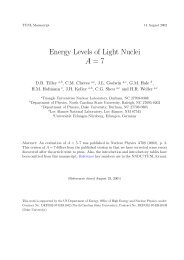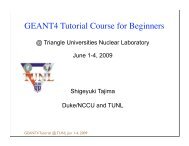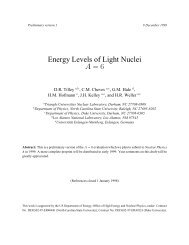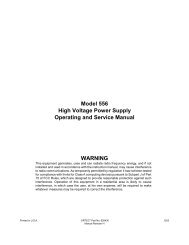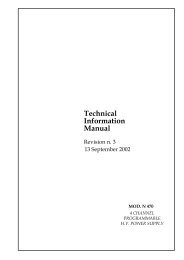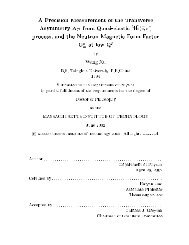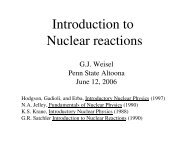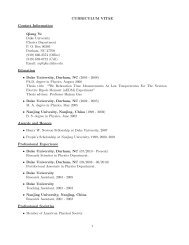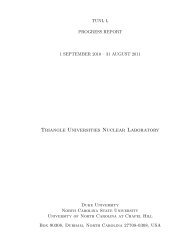Energy Levels of Light Nuclei A = 14 - Triangle Universities Nuclear ...
Energy Levels of Light Nuclei A = 14 - Triangle Universities Nuclear ...
Energy Levels of Light Nuclei A = 14 - Triangle Universities Nuclear ...
You also want an ePaper? Increase the reach of your titles
YUMPU automatically turns print PDFs into web optimized ePapers that Google loves.
For possible resonant structure in (a) see (76AJ04). For reaction (b) see (81AJ01, 86AJ01).<br />
See also (90HA46).<br />
6. 11 B(α, p) <strong>14</strong> C Q m =0.7842<br />
Angular distributions <strong>of</strong> p 0 have been measured at E α = 1.43 to 31.2 MeV: see (76AJ04,<br />
81AJ01, 86AJ01). At E α = 118.1 MeV angular distributions have been studied [DWBA analysis]<br />
to <strong>14</strong> C*(6.09, 6.59, 6.73, 7.01, 8.32, 9.80, 10.43[u], 10.74, 11.38[u], 11.7[u], <strong>14</strong>.67, <strong>14</strong>.87, 15.20, 16.43,<br />
16.72, 17.30, 21.40 [u]). It is suggested that one <strong>of</strong> the states at 11.7 MeV has J π =4 − and the<br />
other J π =(1, 2, 3) − , and that the state at 16.43 has J π =6 − (87AN04). At E α =48MeVan<br />
angular distribution is reported to a state at E x =23.288 ± 0.015 MeV with Γ lab =70± 3keV.<br />
The sharpness <strong>of</strong> the state suggests that J is large, and that perhaps it is a 7 − state (88BR26,<br />
and J.D. Brown, private communication). A search has been made for an 8 − state up to 26 MeV<br />
(at 20 ◦ ): the upper limit for its strength is 0.2 that for the 23.29 MeV state (J.D. Brown, private<br />
communication). See also 15 N, (89BR1J) and(88CA26; astrophys.).<br />
7. (a) 11 B( 6 Li, 3 He) <strong>14</strong> C Q m =4.8027<br />
(b) 11 B( 7 Li, α) <strong>14</strong> C Q m =18.1304<br />
Below E x =10.4 MeV, <strong>14</strong> C*(6.09, 6.73, 6.90 + 7.01, 7.34, 8.32, 9.78) are observed in both<br />
reactions at E(Li) = 34 MeV (84CL08): the states observed at higher excitation energies are<br />
displayedinTable<strong>14</strong>.5. The intensities <strong>of</strong> the 3 He and α groups in the two reactions are significantly<br />
different. Comparison <strong>of</strong> the angular distributions in reaction (a) and in the analog reaction 11 B( 6 Li,<br />
t) <strong>14</strong> N, as well as other data, leads to the assignment <strong>of</strong> analog pairs: see reaction 11 in <strong>14</strong> N. It<br />
is suggested that <strong>14</strong> C*(11.73) and not <strong>14</strong> C*(11.67) is populated in the inelastic pion scattering<br />
(84CL08). For the earlier work on reaction (b), see (76AJ04).<br />
8. 12 C(t, p) <strong>14</strong> C Q m =4.6410<br />
Observed proton groups are displayed in Table <strong>14</strong>.6. Angular distributions have been measured<br />
at E t =5.5 to23MeV[see(81AJ01)] and at 33 MeV (86CO1T; prelim.; to <strong>14</strong> C*(6.09, 6.6[u], 7.01,<br />
8.31, 10.5[u], <strong>14</strong>.87, 16.43). For other results see (86AJ01). See also 15 N.<br />
9. 12 C(α, 2p) <strong>14</strong> C Q m = −15.1731<br />
At E α = 65 MeV angular distributions have been measured to <strong>14</strong> C*(0, 6.73 ± 0.02, 8.40 ± 0.<strong>14</strong>,<br />
10.69 ± 0.05, 11.69 ± 0.06[u], <strong>14</strong>.84 ± 0.4). The two most strongly populated states (or groups <strong>of</strong><br />
states) are <strong>14</strong> C*(6.73, 10.69). J π =1 − and (6 + ,5 − ) are favored for <strong>14</strong> C*(11.69, <strong>14</strong>.84). For the<br />
latter 4 + is considered to be very unlikely: see (86AJ01). See also (81AJ01) for the earlier work.<br />
15


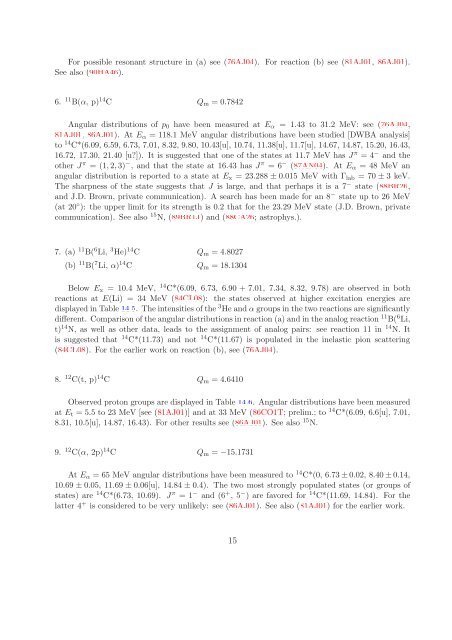
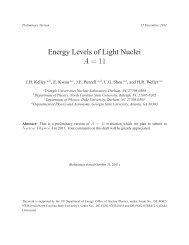

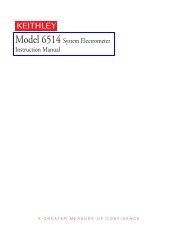
![TUNLXXXIV.tex typeset [1] - Triangle Universities Nuclear Laboratory](https://img.yumpu.com/47618358/1/190x245/tunlxxxivtex-typeset-1-triangle-universities-nuclear-laboratory.jpg?quality=85)
